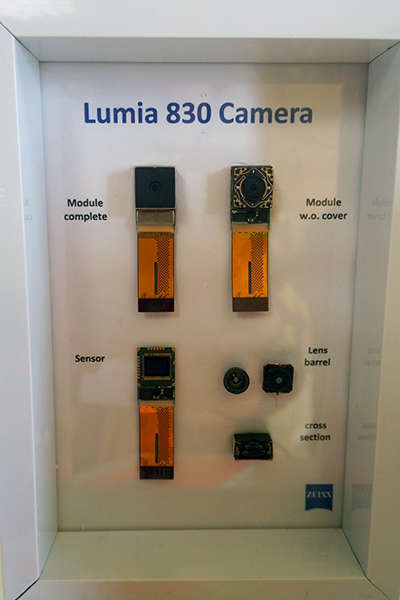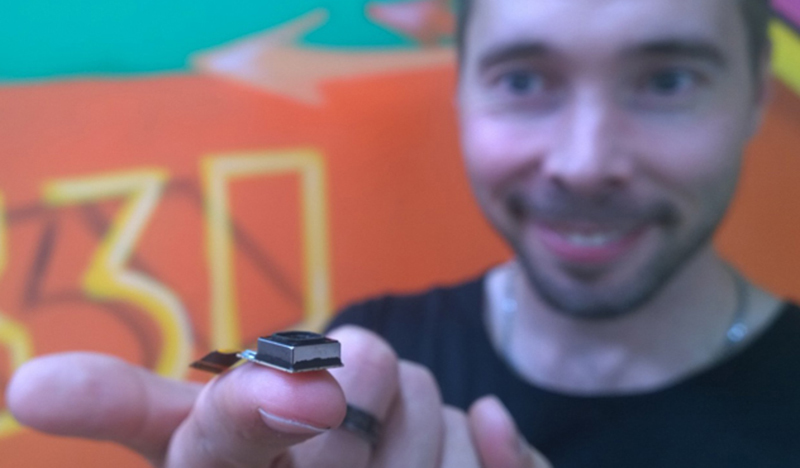Creating PureView: how Zeiss helps us make cameras
In early October, Microsoft announced the start of sales in Russia of new smartphones Lumia 830 and Lumia 730/735 . The devices will be offered at recommended prices - 19,990 and 12,990 rubles, respectively.

Introducing these models a month ago in Berlin, we placed special emphasis on the photo capabilities of these smartphones. So, for example, the Lumia 830 with a shell thickness of only 8.5 has a 10 megapixel camera module with a six-lens optical system. Of course, the development of such complex optics would have been impossible without our long-time partners - the company Zeiss. At the largest international conference in the photo industry, Photokina, our foreign colleagues were able to speak with Oliver Shindelbeck, product research and development manager at Zeiss, and Sandra Gold, head of product marketing at this German company. And today we want to share this interview with you.

')
Many models in our portfolio, ranging from the Lumia 720 and ending with 41 megapixels with the Lumia 1020 photoflagman or our new Lumia 830, carry the Zeiss logo. And this means only one thing - in the photomodule Zeiss Tessar lenses are used, whose history goes back to 1902.
Collaboration with Zeiss, the world leader in optics and optoelectronics, began in 2005 with the Nokia N90 , which was equipped with a 2-megapixel camera and which had a unique design with a turning mechanism. Further, our cooperation only grew and strengthened. Among the highlights: the appearance of optical image stabilization in the Lumia 920, the world's first 41-megapixel smartphones PureView 808 and Lumia 1020, the flagship Lumia 930 with a 20 megapixel camera ... We will definitely return to the topic of cooperation with Zeiss in our next posts, but for now give the floor to our colleagues.

Nokia N90
How did the collaboration between ZEISS and Nokia start?
At the beginning of the 2000s, we watched for a long time how the technology of shooting on mobile phones developed, getting better and better. However, on the other hand, we understood that until compact sensors with a resolution of at least 2 megapixels appear, optical systems will not be of particular importance.
The thing is that starting with 2 megapixels, users could evaluate with a naked eye whether the optical system is installed in their device or not. In the opposite case, the quality of the images still turned out to be extremely low. In 2004, we had a premonition that the camera industry was about to achieve this goal.
We did some research and found out that many mobile phone manufacturers are ready to start cooperation with our company. Without a doubt, Nokia was the best at that time.
At the end of 2004, our management contacted Nokia’s management, and we quickly discovered that we had the same understanding that the ability to take photos becomes a very important function in mobile devices, and the cooperation of our companies will become the best case study in the mobile and photo industry at the same time. As a result, less than three months have passed since our first contact with Nokia before signing the agreement.
How is the collaboration between Zeiss and Nokia engineers in terms of the material and technical base?
We had an almost week-long team-building event when we first started working together. Since then, we have had regular meetings at least twice a year. And when working on current projects, we meet in person, conduct daily newsgroups and send each other piles of emails.
Have you encountered any difficulties when developing camera modules for Lumia?
The usual and always existing difficulty is the size of the camera module and its height. This is one of the most critical things, because it affects the thickness of a mobile phone.
On Lumia devices, like the 41-megapixel Lumia 1020, the camera module must be thicker to fit both the large sensor, the optical system, and the stabilization system. Was it possible to equip such cameras with thinner devices? Developed in conjunction with Microsoft (and Nokia earlier) 20 megapixel camera modules for the thinner Lumia 1520 and Lumia 930, although they hint that a compromise is still inevitable, they are still impressive in their characteristics.

The thinnest of the Lumia line of model 830 is equipped with 10 megapixels and optical image stabilization. Due to the less powerful photomatrix Lumia 830, we needed a smaller lens diameter. Thus, we have created a completely different optical device to make the lens thinner, and thanks to this we also reduced the thickness of the module.
Can you tell us more about how you test cameras designed for Lumia smartphones?
When we have the first prototypes of lenses, modules and ready-made devices, we immediately turn to laboratory and experimental testing. We can simulate almost any weather conditions on the planet: for example, extreme temperatures.

Quality is measured differently. Resolution of images is easy to determine, but this is just one component of the estimated parameter. The overall quality of the images taken cannot be measured and evaluated only by the equipment. For this, a human eye is needed. Fortunately, we have many experts in the field of photography.
Last question. What's next? How will camera phones look and work in the future?
We would like to see camera modules that would be even thinner. As part of the existing technology, we are getting closer and closer to the acceptable limits. If you want to have a decent picture quality when using current technologies, then I would say that 5-6 mm is probably the limit. However, on the approaches there are already other technologies that promise us that in the foreseeable future we can produce significantly more thin modules.

Introducing these models a month ago in Berlin, we placed special emphasis on the photo capabilities of these smartphones. So, for example, the Lumia 830 with a shell thickness of only 8.5 has a 10 megapixel camera module with a six-lens optical system. Of course, the development of such complex optics would have been impossible without our long-time partners - the company Zeiss. At the largest international conference in the photo industry, Photokina, our foreign colleagues were able to speak with Oliver Shindelbeck, product research and development manager at Zeiss, and Sandra Gold, head of product marketing at this German company. And today we want to share this interview with you.

')
Many models in our portfolio, ranging from the Lumia 720 and ending with 41 megapixels with the Lumia 1020 photoflagman or our new Lumia 830, carry the Zeiss logo. And this means only one thing - in the photomodule Zeiss Tessar lenses are used, whose history goes back to 1902.
Collaboration with Zeiss, the world leader in optics and optoelectronics, began in 2005 with the Nokia N90 , which was equipped with a 2-megapixel camera and which had a unique design with a turning mechanism. Further, our cooperation only grew and strengthened. Among the highlights: the appearance of optical image stabilization in the Lumia 920, the world's first 41-megapixel smartphones PureView 808 and Lumia 1020, the flagship Lumia 930 with a 20 megapixel camera ... We will definitely return to the topic of cooperation with Zeiss in our next posts, but for now give the floor to our colleagues.

Nokia N90
How did the collaboration between ZEISS and Nokia start?
At the beginning of the 2000s, we watched for a long time how the technology of shooting on mobile phones developed, getting better and better. However, on the other hand, we understood that until compact sensors with a resolution of at least 2 megapixels appear, optical systems will not be of particular importance.
The thing is that starting with 2 megapixels, users could evaluate with a naked eye whether the optical system is installed in their device or not. In the opposite case, the quality of the images still turned out to be extremely low. In 2004, we had a premonition that the camera industry was about to achieve this goal.
We did some research and found out that many mobile phone manufacturers are ready to start cooperation with our company. Without a doubt, Nokia was the best at that time.
At the end of 2004, our management contacted Nokia’s management, and we quickly discovered that we had the same understanding that the ability to take photos becomes a very important function in mobile devices, and the cooperation of our companies will become the best case study in the mobile and photo industry at the same time. As a result, less than three months have passed since our first contact with Nokia before signing the agreement.
How is the collaboration between Zeiss and Nokia engineers in terms of the material and technical base?
We had an almost week-long team-building event when we first started working together. Since then, we have had regular meetings at least twice a year. And when working on current projects, we meet in person, conduct daily newsgroups and send each other piles of emails.
Have you encountered any difficulties when developing camera modules for Lumia?
The usual and always existing difficulty is the size of the camera module and its height. This is one of the most critical things, because it affects the thickness of a mobile phone.
On Lumia devices, like the 41-megapixel Lumia 1020, the camera module must be thicker to fit both the large sensor, the optical system, and the stabilization system. Was it possible to equip such cameras with thinner devices? Developed in conjunction with Microsoft (and Nokia earlier) 20 megapixel camera modules for the thinner Lumia 1520 and Lumia 930, although they hint that a compromise is still inevitable, they are still impressive in their characteristics.

The thinnest of the Lumia line of model 830 is equipped with 10 megapixels and optical image stabilization. Due to the less powerful photomatrix Lumia 830, we needed a smaller lens diameter. Thus, we have created a completely different optical device to make the lens thinner, and thanks to this we also reduced the thickness of the module.
Can you tell us more about how you test cameras designed for Lumia smartphones?
When we have the first prototypes of lenses, modules and ready-made devices, we immediately turn to laboratory and experimental testing. We can simulate almost any weather conditions on the planet: for example, extreme temperatures.

Quality is measured differently. Resolution of images is easy to determine, but this is just one component of the estimated parameter. The overall quality of the images taken cannot be measured and evaluated only by the equipment. For this, a human eye is needed. Fortunately, we have many experts in the field of photography.
Last question. What's next? How will camera phones look and work in the future?
We would like to see camera modules that would be even thinner. As part of the existing technology, we are getting closer and closer to the acceptable limits. If you want to have a decent picture quality when using current technologies, then I would say that 5-6 mm is probably the limit. However, on the approaches there are already other technologies that promise us that in the foreseeable future we can produce significantly more thin modules.
Source: https://habr.com/ru/post/239757/
All Articles